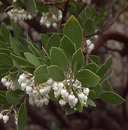Taxon Report
Arctostaphylos manzanita Parry ssp. laevigata (Eastw.) MunzContra Costa manzanita |
 © 2019 Susan McDougall |
Taxon Summary
Arctostaphylos manzanita ssp. laevigata, commonly known as Contra Costa manzanita, is a perennial evergreen shrub in the Ericaceae that is found only in California. It occurs within Chaparral, growing at elevations from 430 to 1100 meters. Arctostaphylos manzanita ssp. laevigata is ranked 1B.2, Plants Rare, Threatened or Endangered in California and Elsewhere; Moderately threatened in California.Classification
|
Scientific Name: |
Arctostaphylos manzanita Parry ssp. laevigata (Eastw.) Munz |
|
Common Name: |
Contra Costa manzanita |
| Family: | Ericaceae |
| Element Code: | PDERI04273 |
| USDA Plants Symbol: | ARMAL |
|
Synonyms/Other Names: |
|
Ecology and Life History
| Lifeform: | perennial evergreen shrub |
| Blooming Period: Jan-Mar(Apr) | Jan-Mar(Apr) |
| Elevation: | 430-1100 (1410-3610) |
| General Habitats: | Chaparral |
| Microhabitat: | |
| Microhabitat Details: |
Conservation Status
| CA Rare Plant Rank: | 1B.2 |
| Global Rank: | G5T2 |
|
State Rank: |
S2 |
| State List: | None |
| Fed List: | None |
| Other Status: | SB_UCSC |
|
CRPR Changes: |
|
Occurrence Data from the CNDDB
| Total Occurrences: | 10 |
| Element Occurrence Ranks: | |
| Excellent (A) | 0 |
| Good (B) | 1 |
| Fair (C) | 1 |
| Poor (D) | 0 |
| None (X) | 0 |
| Unknown (U) | 8 |
| California Endemic: True | |
| California Counties and Islands: Name (Code) | |
| Contra Costa (CCA) | |
| Quads: Name (Quad Code) | |
| Byron Hot Springs (3712176), Clayton (3712188), Diablo (3712178), Tassajara (3712177) | |
Threat List Data from the CNDDB
| Threat List Total: | 6 | |
| EOs with Threat Listed: | Total EOs | % of EOs |
| 5 | 50 % | |
| Improper burning regime | 3 | 30% |
| Other | 2 | 20% |
| Road/trail construction/maint. | 2 | 20% |
| Wood cutting or brush clearing | 2 | 20% |
| Recreational use (non-ORV) | 1 | 10% |
| Biocides | 1 | 10% |
Citation
California Native Plant Society, Rare Plant Program. 2025. Rare Plant Inventory (online edition, v9.5.1). Website https://www.rareplants.cnps.org [accessed 22 November 2025].